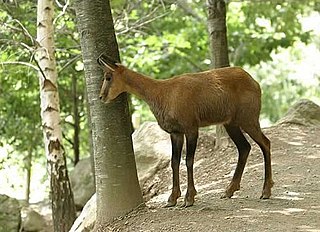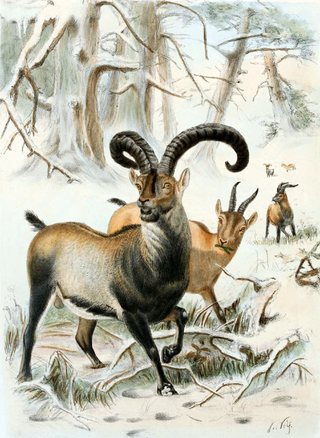
The Pyrenean chamois is a goat-antelope that lives in the Pyrenees and Cantabrian Mountains of Spain, France and Andorra, and the Apennine Mountains of central Italy. It is one of the two species of the genus Rupicapra, the other being the chamois, Rupicapra rupicapra.

The Iberian ibex, also known as the Spanish ibex, Spanish wild goat and Iberian wild goat, is a species of ibex endemic to the Iberian Peninsula. Four subspecies have been described; two are now extinct. The Portuguese ibex became extinct in 1892, and the Pyrenean ibex became extinct in 2000. A project to clone the Pyrenean ibex resulted in one clone being born alive in July 2003, making it the first taxon to become "un-extinct", although the clone died several minutes after birth due to physical defects in its lungs.

Symmoca signatella is a moth of the family Autostichidae. It is known from most of western Europe, but also Lithuania, Croatia, Greece and southern Russia. It has also been recorded from California in North America.

Quercus pyrenaica, also known as Pyrenean oak, or Spanish oak is a tree native to southwestern Europe and northwestern North Africa. Despite its common name, it is rarely found in the Pyrenees Mountains and is more abundant in northern Portugal and north and northwestern Spain.

Symmoca is a genus of moths in the family Autostichidae.

Symmoca achrestella is a moth of the family Autostichidae. It is found in Austria and Italy.
Symmoca alhambrella is a moth of the family Autostichidae. It is found in Portugal and Spain.
Symmoca caliginella is a moth of the family Autostichidae. It is found in France, Austria and Italy.
Symmoca christenseni is a moth of the family Autostichidae. It is found in Greece.
Symmoca dolomitana is a moth of the family Autostichidae. It is found in Austria and Italy.
Symmoca italica is a moth of the family Autostichidae. It is found in Italy.
Symmoca mimetica is a moth of the family Autostichidae. It is found in Spain.
Symmoca petrogenes is a moth of the family Autostichidae. It is found in Spain.
Symmoca sattleri is a moth of the family Autostichidae. It is found in Spain.
Symmoca senora is a moth of the family Autostichidae. It is found in Spain.
Symmoca serrata is a moth of the family Autostichidae. It is found in Portugal and Spain.

Symmoca signella is a moth of the family Autostichidae. It is found in Spain, France, Germany, Switzerland, Austria, Italy, Slovenia, Croatia and Greece.
Symmoca simulans is a moth of the family Autostichidae. It is found in Spain.
Symmoca sorrisa is a moth of the family Autostichidae. It is found in Spain.

The Pyrenean ibex, Aragonese and Spanish common name bucardo, Basque common name bukardo, Catalan common name herc and French common name bouquetin, was one of the four subspecies of the Iberian ibex or Iberian wild goat, a species endemic to the Pyrenees. Pyrenean ibex were most common in the Cantabrian Mountains, Southern France, and the northern Pyrenees. This species was common during the Holocene and Upper Pleistocene, during which their morphology, primarily some skulls, of the Pyrenean ibex was found to be larger than other Capra subspecies in southwestern Europe from the same time.






